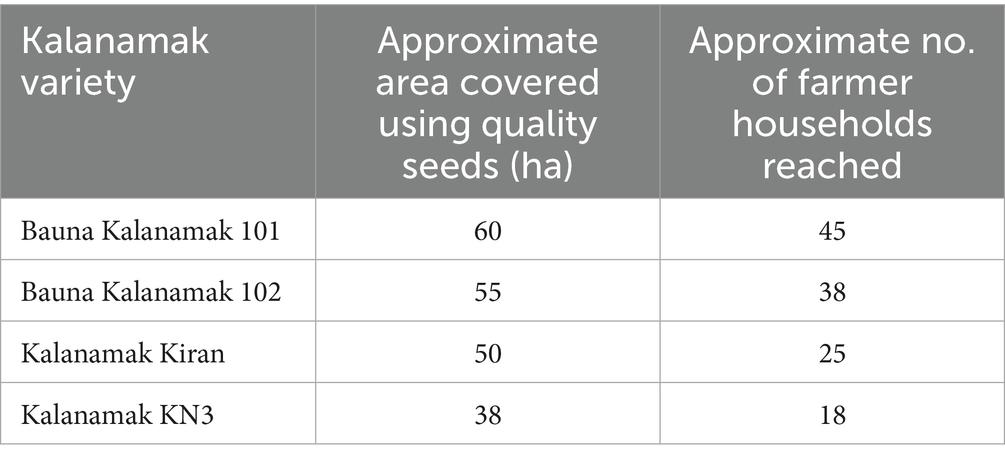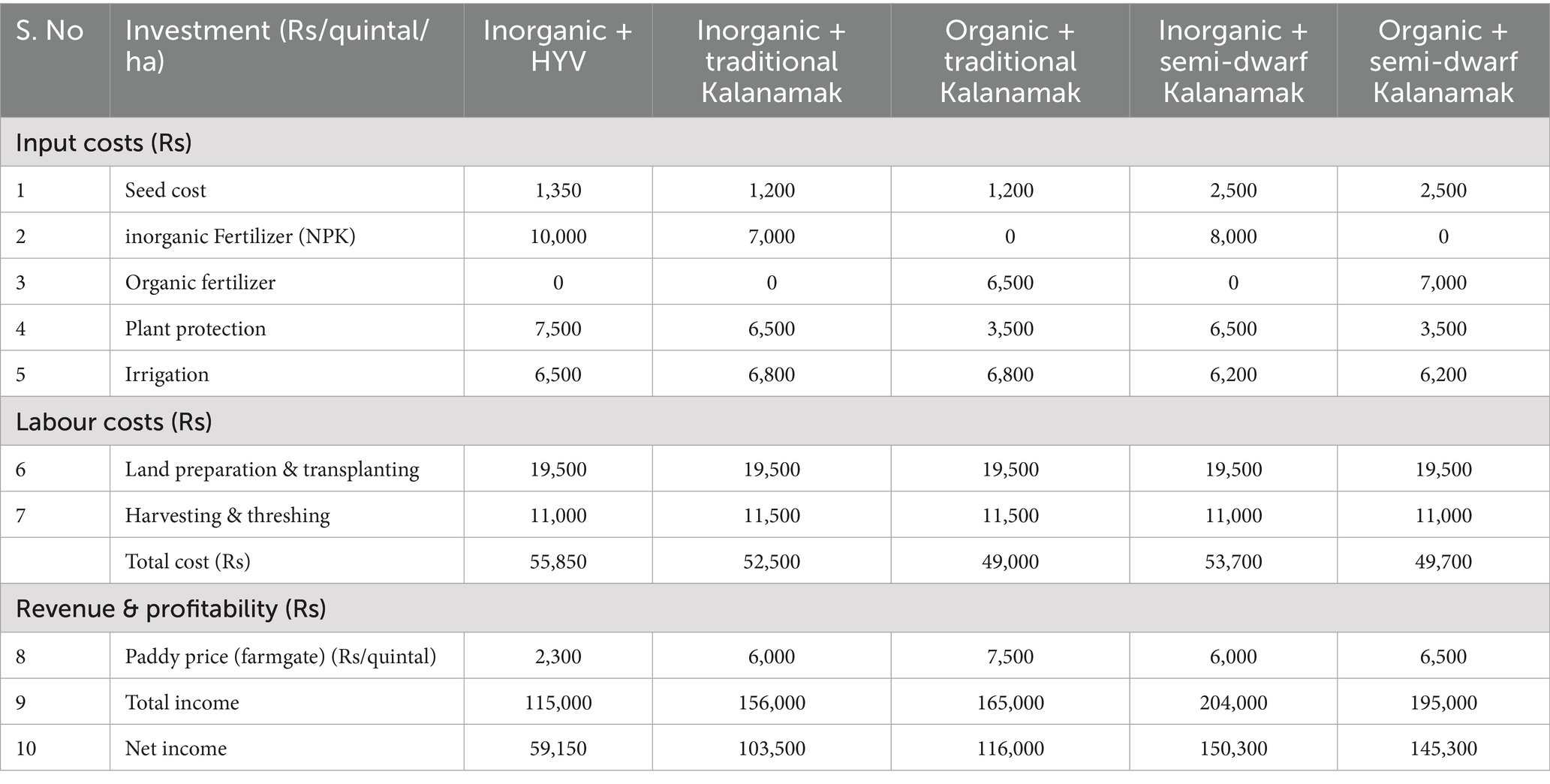- International Rice Research Institute, South Asia Regional Centre, Varanasi, India
Introduction: Kalanamak, an aromatic rice landrace (Oryza sativa L.) traditionally cultivated by indigenous farmers in the Terai belt of Uttar Pradesh, India, has seen a resurgence following the development of improved accessions with higher productivity and market potential. Like other aromatic landraces in India, Kalanamak holds deep socio-economic value, prized for its agroecological resilience, cultural identity, culinary heritage, and role in rural livelihoods.
Methods: The current study focused on three key aspects: (1) comparing the performance of traditional and improved Kalanamak cultivars within the Geographically Indicated (GI) area, (2) mapping the seed and milled rice value chain, and (3) building farmer capacity for quality seed production of improved Kalanamak varieties. Eleven traditional accessions and three improved semi-dwarf varieties of Kalanamak were evaluated through replicated multi-year trials in the GI area. Additionally, a comprehensive value chain assessment of the Kalanamak seed and rice market was conducted through participatory rural appraisal and in-depth interviews with 50 value chain actors, including smallholder farmers, seed growers, millers, and community-based organizations (CBOs).
Results: Semi-dwarf cultivars such as Bauna Kalanamak 101, Bauna Kalanamak 102, and Kalanamak Kiran showed higher mean yield compared to the traditional accessions; however, the differences in yield were statistically non-significant. Findings revealed a hybrid seed network where decentralized farmer-to-farmer exchange coexists with collective-led procurement and emerging private sector channels. To strengthen this evolving system, targeted capacity building in 15 villages in terms of quality seed production was ensured—enhancing farmer skills in varietal selection, purity maintenance, and post-harvest handling—leading to the production of 6,800 kg of quality seeds and improved access to high-performing Kalanamak varieties. Profitability assessment compared traditional and improved cultivars under organic and inorganic practices. Semi-dwarf Kalanamak variants under organic cultivation showed the highest profitability (B:C ratio 3.92), outperforming traditional varieties and inorganic systems. Sensitivity analysis further revealed that semi-dwarf systems remained the most resilient under adverse cost–benefit shifts, consistently maintaining BCRs above 2.0.
Discussion and conclusion: The results affirm that integrating farmer-led seed systems with scientifically validated accessions and localized training can enhance profitability, strengthen seed sovereignty, and revitalize the Kalanamak rice economy in the GI areas. The study underscores the importance of combining participatory approaches with varietal improvement and seed system strengthening to sustain the cultural and economic legacy of Kalanamak rice.
1 Introduction
Rice landraces form the backbone of India’s agroecological heritage, honed over generations to thrive in local conditions. Their inherent resistance to pests, droughts, and diseases reduces dependency on chemical inputs, bolstering soil health and microbial diversity (Rana et al., 2012). Farmers sustain these varieties through indigenous knowledge (Dubey et al., 2023); selecting seeds based on traits aligned with seasonal cycles, soil needs, and ecological balance. Informal community networks have preserved this diversity, enabling farmers to adapt, exchange, and propagate seeds across regions and generations (Vernooy et al., 2020).
The Green Revolution disrupted this equilibrium, replacing landraces with high-yielding varieties (HYVs) (Pingali, 2012). HYVs prioritized productivity but eroded farmers’ seed autonomy, marginalized traditional seed systems, and centralized control under commercial supply chains. This shift depleted genetic diversity, increased vulnerability to climate shocks, and weakened agroecosystems, particularly in marginal farming regions. Concurrently, cultural practices linked to landraces, i.e., festivals, rituals, and traditional cuisines, faded-severing ties to agrarian identity and heritage.
Reviving landraces demands decentralized seed systems that prioritize community-led governance. Empowering farmers to manage seed production, preservation, and distribution restores ecological resilience and cultural sovereignty (Bishaw and Turner, 2008). Such models blend traditional knowledge with scientific innovation, fostering farmer-participatory breeding, strengthening seed systems, and revitalizing local exchange networks. By anchoring seed systems in indigenous wisdom, communities can safeguard biodiversity, enhance climate adaptability, and counter corporate monopolies over seeds (Altieri and Nicholls, 2017).
This study examines the value chain of Kalanamak, an aromatic rice landrace in Uttar Pradesh, to demonstrate how integrating modern genetic interventions such as genetically improved accessions of landraces with traditional seed networks can revive its cultivation (Chaudhary et al., 2024). By analyzing the interplay between modern landrace accessions and varieties, localized seed systems, and existing agrarian knowledge, the research highlights strategies to enhance profitability while preserving cultural and ecological integrity.
2 Materials and methods
The districts of Gorakhpur and Siddharth Nagar in Uttar Pradesh, India, were selected for this study due to their historical association with Kalanamak rice and their recognition under the Geographical Indication (GI) tag (Chaudhary et al., 2017). These districts are part of the Terai region, where Kalanamak has been traditionally cultivated for centuries. The GI tag, granted to Kalanamak from this region, underscores its unique environmental adaptability and cultural significance (Singh et al., 2005).
2.1 Historical significance of Kalanamak rice in the area
Historical records and folklore trace Kalanamak’s origin to the Buddhist era. Renowned for its black husk, fragrant grains, and superior cooking attributes, this heirloom rice once graced royal kitchens and fueled regional trade. However, its cultivation plummeted from 50,000 ha to 2,000 ha between the 1960s and 1990s due to high-yielding varieties, eroding seed availability, and diminished sensory quality (Chaudhary, 2005; Chaudhary et al., 2024). The recent resurgence is primarily triggered by the availability of semi dwarf Kalanamak varieties developed through modern breeding approaches.
Availability of improved varieties such as Kalanamak KN3, Bauna Kalanamak 101, 102, and Kalanamak Kiran (Yadav et al., 2019) highlights the need for a robust farmer-managed seed system for timely access to quality seeds of these improved Kalanamak cultivars. The rising export potential of the landrace and its derived varieties further prioritizes the local farmer’s control over its seed production and distribution. In this regard, decentralized seed systems are key towards strengthening the farmers’ autonomy over seeds and grains, thereby increasing income opportunities of local farmers while preserving the landrace within the communities that have conserved it for generations (David, 2004).
2.2 Multilocation trials for varietal positioning
Eleven traditional Kalanamak accessions and three released Kalanamak varieties (Table 1) were evaluated in a replicated trial across within the Kalanamak Geographical Indication (GI) region of Gorakhpur, Uttar Pradesh. The experiment was conducted during the wet seasons of 2022 and 2023 at Krishi Vigyan Kendra, Belipar, Gorakhpur, Uttar Pradesh, India. Each entry was planted in 25 m2 replicated plots, in a randomized block design. Key agronomic traits-including days to 50% flowering, effective tillers per hill, plant height, panicle length, filled and unfilled grains per panicle, lodging percentage, and grain yield were systematically recorded to assess performance stability and yield potential under in-situ conditions.
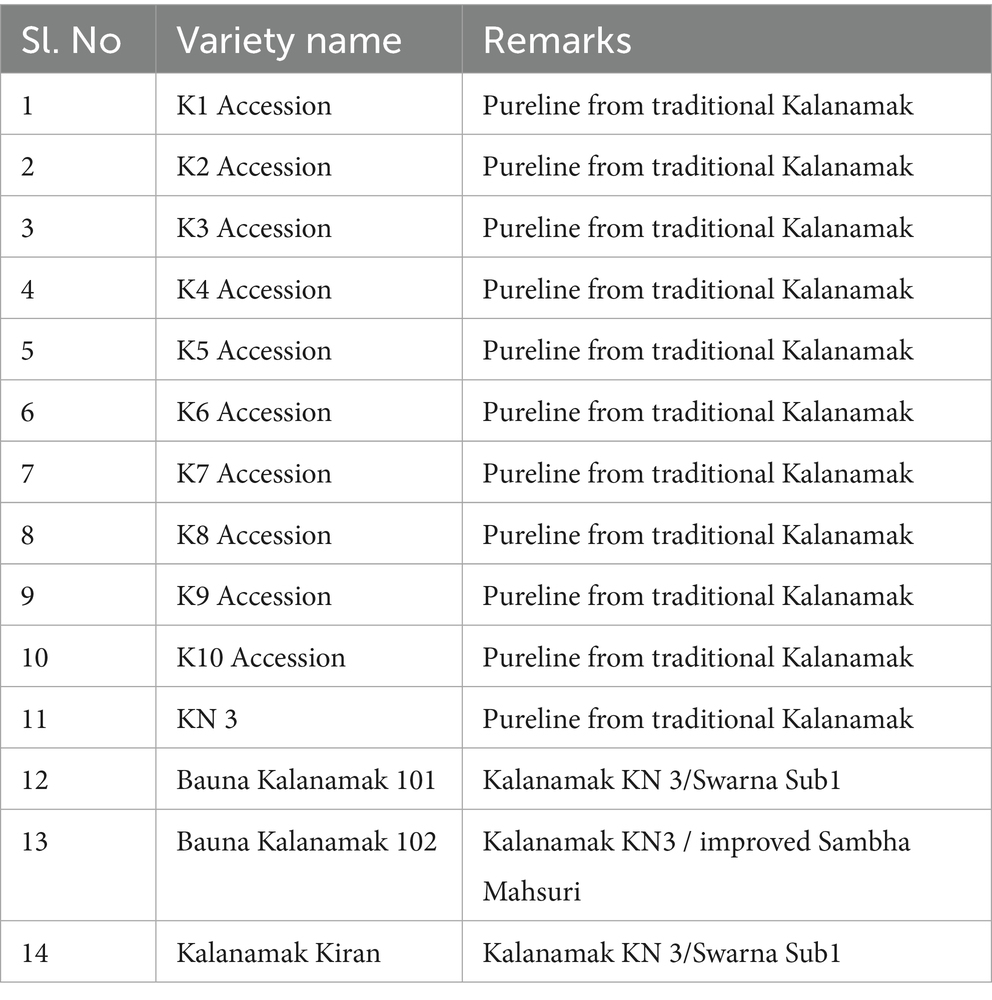
Table 1. Kalanamak accessions and varieties evaluated under multi-location farmer participatory trials.
2.3 Introduction of new Kalanamak varieties and capacity development in seed production and marketing
The introduction and capacity development intervention for seed production of new Kalanamak cultivars integrated indigenous practices with modern agronomic protocols across key cultivation areas. Thirty farmers (25 male and 5 female) from 15 villages within GI areas of Gorakhpur and Kushinagar were identified as master trainers, owing to their association with two local CBOs (Cluster Based Organizations/FPCs) engaged with Kalanamak cultivation and marketing. The farmers were guided in variety selection, distinguishing semi-dwarf cultivars from traditional accessions through phenotypic markers such as plant height, pigmentation, and maturity period, supplementing the existing knowledge available to them through generational observation. Field preparation combined organic soil enrichment (50–60 quintals/ha FYM) with precise plant to plant and row to row spacing (20 cm × 15 cm for semi-dwarf against 25 cm × 20 cm for traditional varieties), optimizing tillering while sustaining historical planting norms practiced traditionally by the farmers.
Nutrient management combined split-dose of NPK application (80:40:40 kg/ha) for semi-dwarf types with traditional organic regimens: Panchagavya foliar sprays and green manure incorporation to preserve aroma and soil health, especially in traditional Kalanamak plots. Genetic purity protocols emphasized roguing at critical growth stages; leveraging farmers’ ability to identify off-types using height difference (traditional: 140–150 cm; semi-dwarf: 90–110 cm) and panicle traits. Ensuring 50 m isolation buffers and staggered planting, paired with modern record-keeping to track varietal integrity helped in sustaining genetic purity of the introduced Kalanamak varieties.
Integrated pest management strategies were communicated to the farmers, which involved neem-based biopesticides and marigold intercropping supplemented with need-based herbicide use and scouting. The capacity building exercises further emphasized post-harvest handling, which retained artisanal practices (hand-threshing, bamboo-bin storage) while introducing moisture meters during drying to maintain a grain moisture of ≤12%, ensuring market-grade quality without compromising sensory attributes.
This hybrid model facilitated farmer’s agency over the Kalanamak seed systems, enabling 30%–80% yield gains through the semi-dwarf cultivars while safeguarding traditional Kalanamak’s legacy. By valorizing indigenous knowledge, the capacity building program ensured agroecological resilience, demonstrating that productivity and cultural preservation are synergistic, not antagonistic, in heirloom crop revitalization.
2.4 Participatory rural appraisal and in-depth interview for tracking Kalanamak conservation-marketization pathways and profitability pre and post intervention
The current study employed an exploratory case study designed to elucidate the interplay between formal and informal seed systems and market dynamics within Kalanamak’s Geographical Indication (GI) regions. Grounded in a participatory framework, the research positioned local farmers, cluster-based organizations (CBOs), and market intermediaries as co-analysts, ensuring their lived experiences shaped the inquiry.
A purposive sampling strategy was adopted to select 50 key actors across five seed networks, viz. (1) NGOs—10 members (including leadership and program organizers) from two NGOs based in Gorakhpur and Siddharth Nagar GI areas; (2) cluster-based organizations (FPO/FPC/SHGs)—25 farmers involved in Kalanamak cultivation across 2 Women led self-help groups (SHGs) and 3 farmer producer companies (FPCs); (3) one local seed bank (4) agricultural universities—2 senior officials from local institutions; and (5) individual farmer producers—7 farmers (not linked with FPOs or FPCs). Additionally, market nodes such as 4 local vendors and distributors, 2 large millers and Kalanamak exporters were interviewed.
Stratified representation for farmers ensured inclusion of smallholders (<1 ha), medium-scale farmers (2–3 ha), and women-led enterprises to capture diverse agroecological and socioeconomic contexts. Ethnographic and ethnobotanical approaches, combined with farmer participatory inquiry, have been shown to be highly effective in elucidating indigenous rice-based cropping systems. This is evidenced by earlier studies (e.g., Pfeiffer et al., 2006; Loko et al., 2021; Gao, 2003).
Data collection integrated three complementary methods: semi-structured interviews (n = 28), focus group discussions (FGDs; n = 5), and participant observation. In-depth interviews with seed producers, CBO leaders, and traders probed decision-making rationales, such as preferences for specific seed sources or market pathways for Kalanamak. FGDs, segmented by actor types utilized participatory tools like flow diagrams to visualize seed procurement practices and mechanisms prevalent in the area. Participant observation at local markets and CBO procurement events provided contextual insights into transactional norms and trust-based exchanges. Semi-structured discussions around themes related to seed genetic purity, market accessibility, and profitability drivers provided valuable insights, while historical timelines mapped the evolution from informal barter systems to formalized seed networks.
Analytical procedures involved iterative thematic coding of transcripts and field notes for identifying emergent patterns. Triangulation approaches involved validating farmer narratives with CBO records and market transaction data to elucidate seed flows and economic behaviors. Comparative analysis of cost–benefit (BC) ratios across production systems (organic/inorganic, traditional/semi-dwarf Kalanamak cultivation) helped establishing links between the various cultivation practices to farmers’ profitability. This methodological synergy bridging participatory narratives with empirical validation captured the complex socio-economic relations underpinning Kalanamak’s value chains in the GI area.
2.5 Economic evaluation: NPV, BCR, and sensitivity analysis
An economic evaluation of five Kalanamak rice production systems was undertaken to assess their comparative viability and resilience. The production systems analyzed include: (i) Inorganic cultivation with high-yielding varieties (HYVs) (inorganic + HYV), (ii) Inorganic cultivation with traditional Kalanamak (inorganic + traditional Kalanamak) (iii) Organic cultivation with traditional Kalanamak (organic + traditional Kalanamak) (iv) Inorganic cultivation with semi-dwarf Kalanamak (inorganic + semi-dwarf Kalanamak), and (v) Organic cultivation with semi-dwarf Kalanamak (organic + semi-dwarf Kalanamak).
For each system, farm-level production costs were estimated on a per-hectare basis, including seed, fertilizer, labor, and crop management expenses. Benefits were calculated from farm-gate paddy prices. To account for the time value of money, a Net Present Value (NPV) analysis was performed over a two-year horizon at an 8% discount rate.
In parallel, the Benefit–Cost Ratio (BCR) was computed using base (undiscounted) values, expressed as the ratio of gross benefits to total costs per hectare. To test the robustness of results, a sensitivity analysis was conducted by jointly varying the incurred costs and benefits by ±10 and ±20%. Four scenarios were generated: best-case (+20% benefits, −20% costs), worst-case (−20% benefits, +20% costs), moderate-best (+10% benefits, –10% costs), and moderate-worst (−10% benefits, +10% costs). Resulting BCRs were compared against base values to evaluate the resilience of each system under changing market and input conditions. This combined framework provided insights into both the absolute profitability and the relative stability of Kalanamak rice production systems across alternative management practices.
3 Results and discussions
3.1 Multilocation trials and varietal positioning
The pooled grain yield performance of the Kalanamak accessions and check varieties across Kharif 2022 and 2023 is presented in Figure 1. The mean yield of the checks was 3.38 t ha−1, which was used as the benchmark for assessing the test entries (Kalanamak accessions). Among the checks, Kalanamak Kiran recorded the highest mean yield (3.7 t ha−1), followed by Bauna Kalanamak 102 (3.3 t ha−1) and Bauna Kalanamak 101 (3.2 t ha−1), reaffirming the relatively superior and stable performance of the improved checks compared with the germplasm accessions of the traditional landrace. However, analysis of variance (ANOVA) did not reveal statistically significant differences between entries and checks (F = 1.28; p = 0.324), and subsequent pairwise comparisons using Tukey’s HSD test confirmed the absence of statistically significant yield differences (p > 0.05). Most of the test accessions (K1 to K10 and KN3) exhibited grain yield (pooled) ranging from 2.3 to 3.2 t ha−1, with most falling marginally below the check. Accessions K4, K7, and K9 performed comparatively better within the test set, with yields of 3.0 to 3.2 t ha−1. In contrast, accessions K3 (2.3 t ha−1) and K8 (2.4 t ha−1) consistently recorded the lowest yields, indicating limited potential for direct varietal release without further genetic improvement. This suggests that the observed variability in yield was largely due to environmental or residual factors rather than genetic effects (Supplementary Table 1).
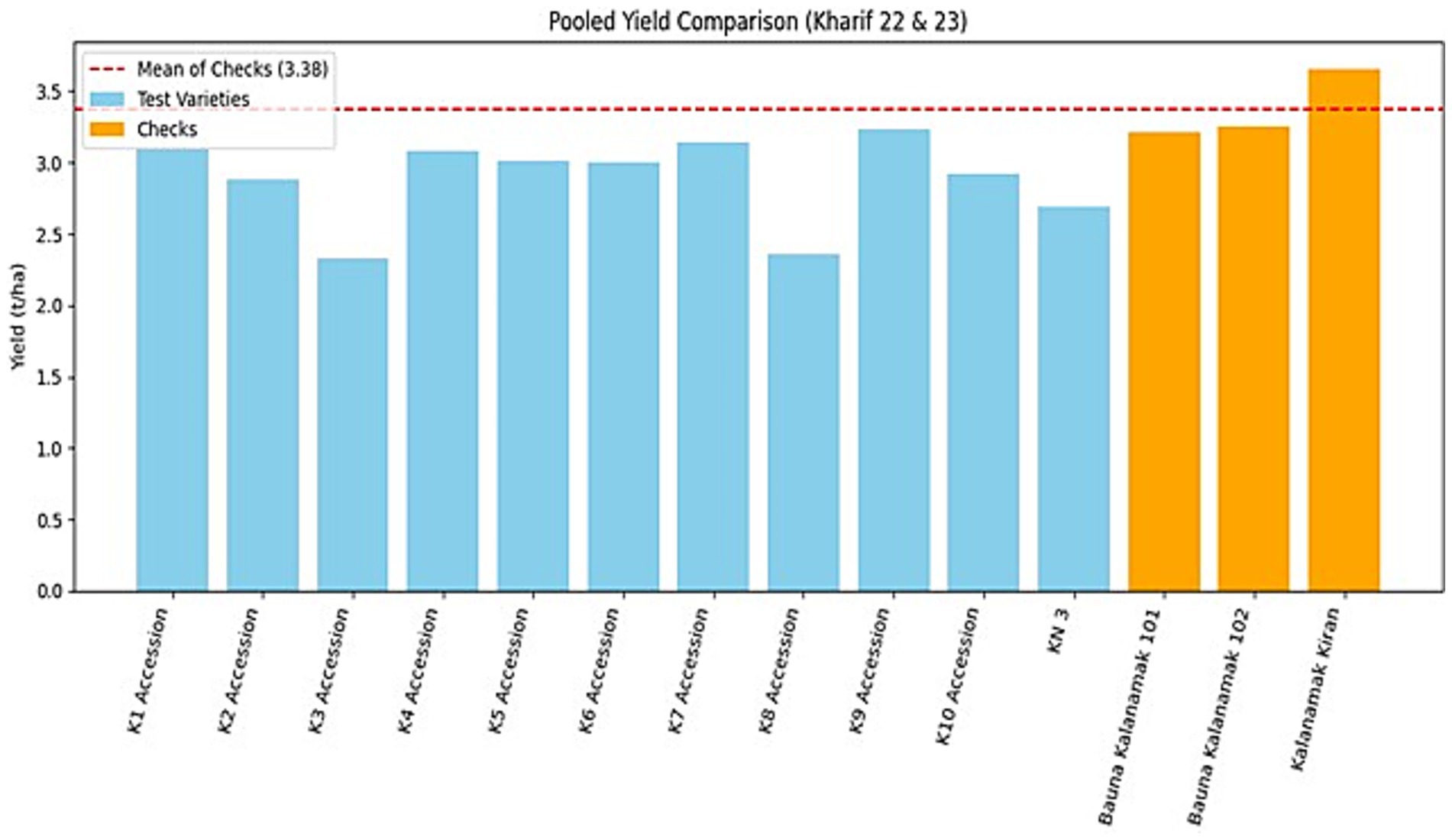
Figure 1. Pooled grain yield performance of Kalanamak accessions (K1 to K10 and KN3) and check varieties (Bauna Kalanamak 101, Bauna Kalanamak 102, and Kalanamak Kiran) across Kharif 2022 and 2023. Bars represent mean yields (t ha−1); accessions are shown in blue and checks in orange. The dashed line indicates the overall mean yield of checks (3.38 t ha−1).
The correlation analysis of key agronomic traits provided insights into the interactions among various phenotypic traits influencing grain yield. A significant negative correlation (r = −0.634, p < 0.01) was observed between days to 50% flowering and yield, suggesting that early flowering genotypes tend to produce higher yields. Effective tillers per hill showed a strong positive correlation (r = 0.755*, p < 0.001) with yield. Conversely, plant height exhibited a significant negative correlation with yield (r = −0.690, p < 0.01), highlighting that taller plants may have reduced efficiency in resource utilization or increased susceptibility to lodging, ultimately lowering yield (Figure 2). These findings emphasize the importance of breeding and adoption of early-maturing, semi-dwarf, high-tillering Kalanamak genotypes to enhance yield potential.
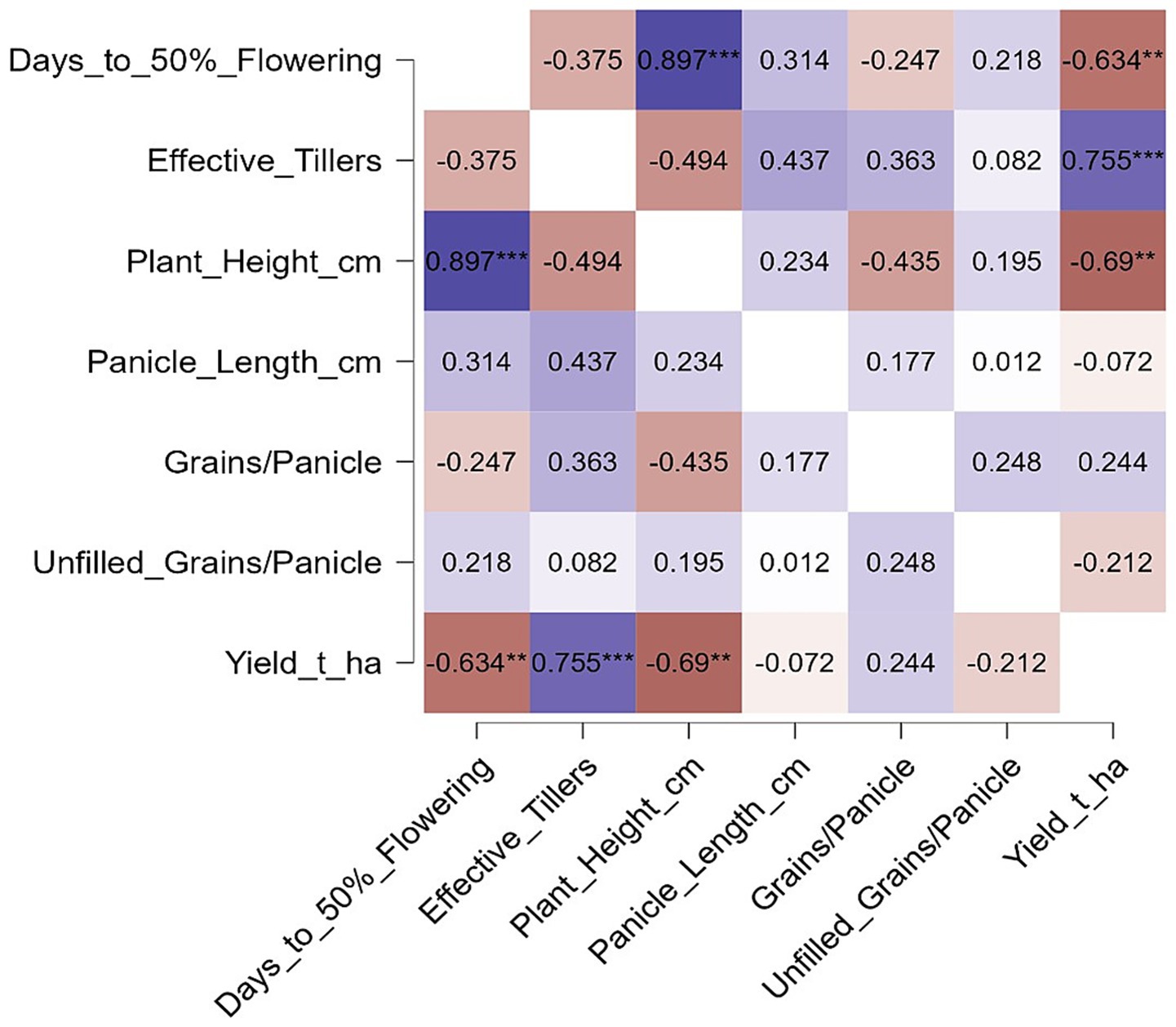
Figure 2. Correlation analysis between seven morphological traits at ***p < 0.001 and **p < 0.01 significance levels.
3.2 Kalanamak rice seed system in GI areas
The participatory analysis uncovered five principal sources of Kalanamak seeds in the GI areas: (1) NGOs, (2) FPO/FPCs, (3) farmer-to-farmer exchanges, (4) agricultural universities, and (5) local seed banks. Analysis revealed that NGOs and FPO/FPCs, collectively known as cluster-based organizations (CBOs), consistently emerged as the dominant suppliers for farmers. Findings further reveal a bidirectional flow of seeds, wherein CBOs not only distributed seeds to farmers but also procured seeds from growers within the same communities or representing the farmer collective. This bidirectional flow, driven by kinship ties and institutional contracts, exemplifies adaptive reciprocity, associated with the CBO-led localized seed procurement pathway. The critical role of social ties in influencing seed exchange has been extensively documented in studies focusing on sorghum-based systems (Labeyrie et al., 2016; McGuire, 2008).
“Sharing seed isn’t a business transaction here-it’s a promise that if I help you succeed today, you’ll help me tomorrow. That promise is there among us (farmers).” (Farmer, Female, age 45, Piprauli village, Gorakhpur)
However, the respondents indicated that the emergence of organized seed procurement network through CBOs marks a shift from historically entrenched informal networks, as indicated by the Kalanamak producers in the GI area. Farmer-to-farmer exchanges mediated through monetary transactions or bartering of milled grains served as the predominant mechanism for seed flow for ages in the area. The significance of barter as a method of seed exchange has been highlighted in earlier studies (Schöley and Padmanabhan, 2017). These traditional exchanges were not merely transactional but embedded within socio-cultural practices, reinforcing localized farmer-led selection and the adaptive management of Kalanamak landrace in the region. This decentralized system further enabled in-situ conservation of the cultivar., ensuring the continuity of heterogeneous Kalanamak accessions as recalled by local farmers.
"In our days, we didn’t buy seeds from shops. We shared them-between families, among neighbors, after harvest. That’s how Kalanamak stayed with us.” (Farmer, Male, age: 71, Piprauli village, Gorakhpur)
The role of informal seed exchange pathways in in-situ conservation has been earlier evinced by Pautasso et al. (2013) and in rice landraces by Pandey et al. (2011) and Mishra et al. (2013). However, the respondent farmers indicated that in last decade there has been an increase in demand for Kalanamak, which the local farmers could not capitalize since many of the farmers shifted to cultivation of high yielding varieties leading to a degradation of existing informal seed networks and absence of strong seed system for the landrace.
“Now people ask for Kalanamak, but the seed isn’t easy to find anymore. Earlier, we passed it hand to hand, field to field. But when farmers moved to other varieties, those old links broke. The seed stayed with a few, and now even they struggle to keep it pure.” (Farmer, Male, age: 55, Motichak village, Kushinagar)
This has led to the emergence of formalized and semi formalized seed procurement pathways, as highlighted by CBO leaders and seed growers in the region. Despite the increasing role of CBOs in formalizing seed procurement, farmer-to-farmer exchanges still persist and primarily practiced by smallholders in the region, reflecting the continued reliance on trust-based networks and localized seed knowledge. The co-existence of formalized and informal mechanisms of seed procurement underscores the fluidity of seed access pathways; where institutional interventions do not fully displace embedded community practices but rather interact with them in complex ways.
The respondents further indicated that few private seed companies have started marketing Kalanamak seeds through local dealer networks. The emergence of private seed companies, albeit on a limited scale, signals a nascent commercialization of Kalanamak seeds, mediated through local dealerships. Universities and local seed banks additionally function at the periphery of direct seed distribution, their roles in conservation are distinct yet interconnected: local seed banks act as repositories for in-situ conservation, sustaining landrace availability within farming communities, whereas universities contribute to ex-situ conservation, safeguarding the genetic integrity of Kalanamak accessions for long-term breeding and research efforts.
These findings reveal a nuanced interplay between tradition and transformation, where multiple actors and mechanisms shape the evolving contours of the Kalanamak seed system. The interaction between formal seed production initiatives and deeply rooted informal exchange networks highlights an adaptive, hybrid model of seed distribution; one that is neither wholly institutionalized nor entirely community-driven but rather situated within a continuum of evolving practices, negotiations, and embedded socio-ecological relations (see Figure 3).
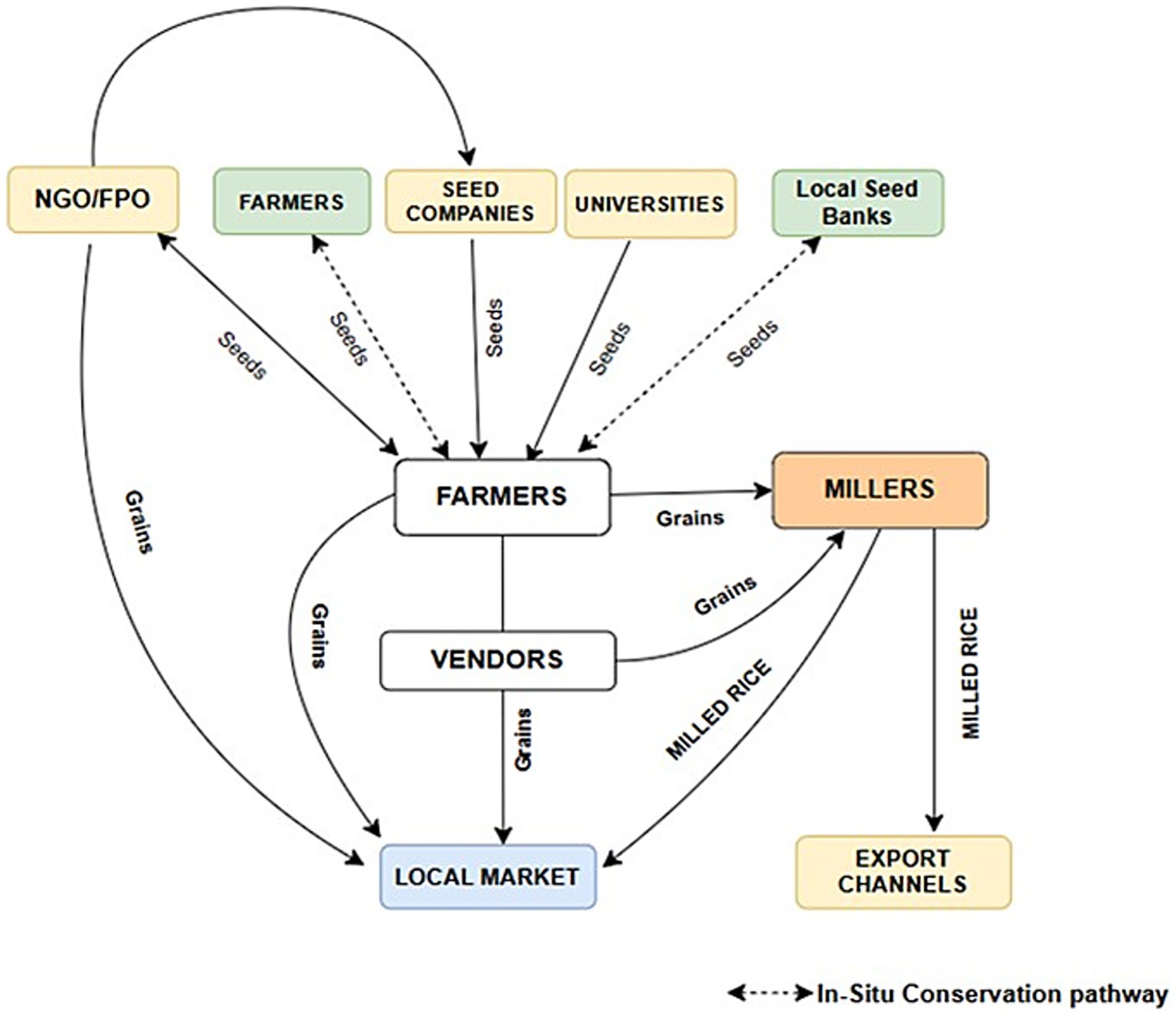
Figure 3. Illustrative flow of seed and grain exchanges in the Kalanamak rice value chain: mapping institutional and informal linkages based on insights from farmer interviews and focus group discussions.
3.3 Capacity development and quality seed production program
Based on the predominant role of CBOs in seed production, the capacity development program for Kalanamak, conducted by the International Rice Research Institute, primarily focused on farmer collectives in the region, integrating their traditional production practices with new semi dwarf high yielding varieties. The capacity development exercises along with linkage to foundation seeds helped in amplification and availability of quality seeds for new semi dwarf high yielding Kalanamak varieties in the area. Following the identification of superior Kalanamak rice varieties through multi-year field trials, a total of 200 kg of foundation seeds (FS) were distributed to 30 farmers trained under the capacity building program. The allocation included 50 kg each of the following varieties: Bauna Kalanamak 101, Bauna Kalanamak 102, Kalanamak Kiran, and KN3. Through the implementation of a training program and mentorship support, 30 farmers from two community-based organizations (CBOs) successfully coordinated the cultivation of improved Kalanamak varieties. Together with their member farmers, they produced the following quantities of Kalanamak seeds: 1,900 kg of Bauna Kalanamak 101, 1,750 kg of Bauna Kalanamak 102, 1,600 kg of Kalanamak Kiran, and 1,550 kg of KN3. The seed multiplication ratio of 1:38 (Bauna Kalanamak 101), 1:35 (Bauna Kalanamak 102), 1:32 (Kalanamak Kiran), and 1:31 (Kalanamak KN3), were recorded for the Kalanamak varieties cultivated following optimum practices (Figure 4). In terms of area coverage and farmer outreach, the coordinated efforts of community-based organizations (CBOs) enabled the dissemination of quality seeds across approximately 203 hectares, benefiting nearly 126 farmer households (Table 2) paving the way for possible spillovers in the future. Among the varieties, Pusa Narendra Kalanamak 1 covered the highest area (70 ha) and reached 53 farmer households, followed by Bauna Kalanamak 101 and Bauna Kalanamak 102. These figures reflect the growing adoption of improved Kalanamak lines and the role of organized farmer networks in strengthening local seed systems and scaling quality seed access in GI-tagged regions. Important role of the informal seed system has been noted in the conservation and cultivation of rice landraces in the higher Himalayas, particularly in Uttarakhand. About 96% of the seed supply in this region comes from informal sources, mainly involving locally adapted landraces (Pandey et al., 2011). Similarly, women-led community seed banks have played a key role in conserving and producing seeds of traditional rice, barley, and millets through informal and decentralized systems (Rengalakshmi et al., 2024).
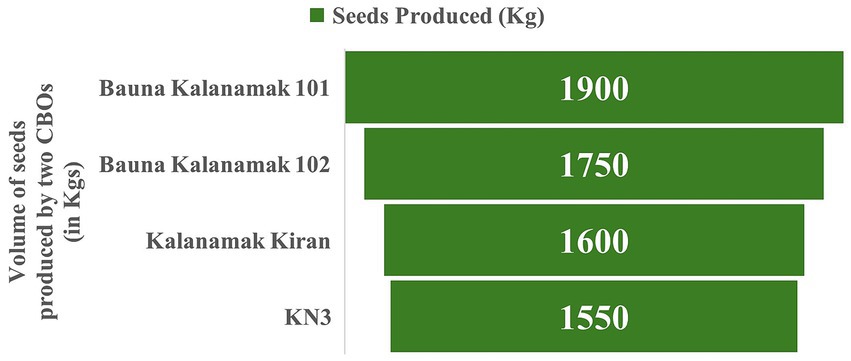
Figure 4. Volume of quality Kalanamak seeds produced by beneficiary farmers linked with two CBOs in GI area.
3.4 Milled rice value chain for Kalanamak in GI areas
The in-depth interviews and FGDs conducted in the intervention areas provided nuanced insights into the emergent market pathways and economic dynamics associated with grains and milled rice derived from high-yielding Kalanamak varieties. A predominant pattern that emerged from the narratives indicated that farmers primarily engaged with local vendors as their first point of sale, with these vendors subsequently channelling the grains into larger market networks or ‘mandis’. This practice was especially common in villages located far from major mandi centres namely, Dibiyapur, Mahulani, Bajha, Aligarhwa and Bazardih villages. Furthermore, vendors with established linkages to small and medium-scale rice millers played a pivotal role in extending market reach, as they facilitated the movement of grains into the milling sector.
“Most of us can’t make the long trip to the mandi or miller-so we sell to the village vendor. He comes right to our fields and pays us on the spot.” (Farmer, Male, age: 52, Dibiyapur Village, Siddharth Nagar)
A distinct pattern emerged among farmers cultivating Kalanamak rice on larger landholdings (over 2–3 ha) situated close to major town mandis. These growers strategically transact directly with millers or sell their paddy at nearby mandis such as those in Uska Bazar and Naugarh-to maximize returns by bypassing intermediaries.
“Why should I hand over my hard-earned grain to a vendor when I can drive it straight to Uska Bazar myself? Why pay a middleman to clip my profits?” (Farmer, Male, age: 41, Uska Bazar, Siddharth Nagar)
In depth interviews with rice millers indicated that majority of the millers sold the milled rice across local markets through distribution channels, yet a section of the larger rice mills has intensified export of the Kalanamak rice through different channels as confirmed in the study by Chaudhary et al. (2022).
A comparative analysis of the farm-gate profitability of Kalanamak rice revealed a nuanced insight into the relationship between variety selection, production practices, and economic returns. The study captured variations in cost–benefit ratios (BC ratios) based on both the genotype used (traditional vs. semi-dwarf high-yielding varieties) and the nature of cultivation (organic vs. inorganic) (Table 3).
Among the respondents, a substantial proportion (38%) cultivated traditional Kalanamak cultivars with a limited use of conventional chemical fertilizers, while 23% adopted fully organic inputs-comprising organic fertilizers and plant protection products for the same traditional cultivars. For many consumers and farmers, traditional Kalanamak rice holds unmatched appeal because of its signature aroma, soft texture, and the cultural value attached to its age-old reputation. Its distinct black husk at maturity is widely seen as a marker of authenticity and heritage. However, several farmers have noted a deviation in aroma and perceived quality in the released high-yielding variants, raising concerns about the genetic purity of the seeds currently available for these improved lines. At the same time, while farmers value the heritage traits of Kalanamak, many also consider the advantages of improved varieties, which are shorter in stature and higher yielding, and therefore carry lower production risks. Still, the strong consumer preference for the unique taste of traditional Kalanamak continues to motivate farmers to cultivate its traditional accessions across significant acreages.
“Now consumers come to us looking for grains of the traditional varieties due to unique soft texture than their improved counterparts, and willing to pay higher price for it—which is pushing us to continue with cultivation of both segments.” (Farmer, Male, age: 48, Siddharth Nagar)
Notably, 27% of respondents engaged in the cultivation of semi-dwarf high-yielding Kalanamak varieties under organic management, reflecting a shift towards input efficiency and sustainability. A relatively smaller segment (12%) cultivated semi-dwarf Kalanamak using inorganic/ chemical inputs.
“I grew the Bauna varieties (semi-dwarf Kalanamak) using only organic methods-compost and biopesticides….and harvested nearly the same yield with half the input cost. Best of all, my soil stays healthy and fertile for future seasons.” (Farmer, Male, age: 50, Naugarh, Siddharth Nagar)
4 Economic and sensitivity analysis of Kalanamak production systems
Farm-level costs and farm-gate paddy prices in the intervention area over a two-year period was used to conduct an NPV analysis at an 8% discount rate at 2 years horizon, which revealed that all production systems were economically viable, generating positive NPVs (Tables 3, 4). Among the scenarios, organic + semi-dwarf Kalanamak demonstrated the highest economic viability, with a two-year net present value (NPV) of ₹2,59,108.37 and the highest benefit–cost ratio (BCR) of 3.92. This was closely followed by the inorganic + semi-dwarf Kalanamak system, which also recorded a high NPV (₹2,68,024.69) and a BCR of 3.80, indicating strong returns relative to costs.

Table 4. Net present value (NPV) at 8% discount rate, over 2 years, and benefit–cost ratio (BCR) of Kalanamak production systems.
The organic + traditional Kalanamak system performed better than its inorganic counterpart (inorganic + traditional Kalanamak), achieving an NPV of ₹2,06,858.71 and a BCR of 3.37 compared to ₹1,84,567.90 and 2.97, respectively. In contrast, the inorganic + high-yielding variety (HYV) system, while positive in returns (NPV ₹1,05,480.11; BCR 2.06), lagged considerably behind Kalanamak-based systems.
The sensitivity analysis of combined cost and benefit variations (Table 5) confirmed that all production systems remain viable, with BCRs above 1.0 across scenarios. However, the magnitude of change varied notably. In the worst-case scenario (−20% benefits, +20% costs), BCRs declined substantially, with maximum decline in inorganic + HYV system (falling to 1.32), while the semi-dwarf Kalanamak systems retained stronger outcomes (2.28 in case of inorganic and 2.61 for organic systems). Under the best-case scenario (+20% benefits, −20% costs), the organic + semi-dwarf Kalanamak achieved the highest BCR (5.89), followed closely by the inorganic + semi-dwarf system (5.70). Moderate adjustments (+10% benefits. –10% costs) produced similar trends, with BCRs of 4.74 and 4.51, respectively, for organic and inorganic semi-dwarf systems, compared to only 2.51 for inorganic + HYV. Overall, the results highlight that while profitability is sensitive to benefit fluctuations, semi-dwarf Kalanamak systems are the most resilient and profitable options across varying conditions.
5 Conclusion
This study critically analyzed the Kalanamak seed system and rice value chain within its GI-designated (GI) region. Through stakeholder interviews and FGDs, the study uncovered the intricate social relationships that have historically sustained this landrace over centuries and continue to influence its contemporary market dynamics. These networks, rooted in trust and intergenerational knowledge exchange not only ensured the landrace’s conservation but also determined its evolving commercialization pathways.
A key barrier to scaling Kalanamak production namely, limited varietal positioning and inconsistent seed availability was identified as a systemic challenge. To address this, the study emphasizes the urgency of capacity-building initiatives for local seed growers, which could strengthen semi-formal seed systems and enhance farmer agency over the landrace and its derived varieties. The Kalanamak market stands at a critical juncture, marked by tensions between full commodification and enduring informal exchange mechanisms.
To ensure equitable benefits for primary growers amid rising demand, the study argues for reinforcing farmer-centric seed systems in the region. Important policy recommendations should focus on:
• Institutionalizing decentralized seed systems for landraces within state and national seed policy frameworks.
• Establishing dedicated funding lines under central and state agricultural schemes to support community-managed seed production units in GI-designated regions.
• Incorporating landrace promotion into public procurement programs, such as the Public Distribution System (PDS) and school feeding schemes, to create stable demand.
• Developing region-specific seed certification and quality assurance protocols for traditional varieties to protect authenticity and farmer ownership rights.
• Facilitating convergence between departments of agriculture, horticulture, and rural development for integrated promotion of landraces through seed, market, and branding support.
Such systems would empower farmers to retain control over the landrace’s genotype and associated agronomic traits, enabling them to capitalize on market opportunities while safeguarding both social and agroecological resilience. Future studies should explore how decentralized seed systems for landraces like Kalanamak contribute to rural income generation, particularly for smallholders and marginalized groups. Furthermore, future studies can analyze how strengthened decentralized seed networks for high-value landraces like Kalanamak can enhance women farmers’ decision-making power, control over resources, and participation in markets.
Data availability statement
The original contributions presented in the study are included in the article/Supplementary material, further inquiries can be directed to the corresponding author.
Ethics statement
Ethical approval was not required for the studies involving humans because International Rice Research Institute has internal evaluation and ethics clearance process for the studies which involves extensive household interviews and detailed personal data collections. However, this study is a mixed method study relying on participatory interaction, case study and secondary literature reviews and market analysis and does not involve any sensitive and extensive human data and information to be processed through that committee. However, the manuscript is processed for internal peer review for quality, before the submission here. The studies were conducted in accordance with the local legislation and institutional requirements. Written informed consent for participation was not required from the participants or the participants’ legal guardians/next of kin in accordance with the national legislation and institutional requirements.
Author contributions
SN: Conceptualization, Funding acquisition, Project administration, Methodology, Writing – original draft, Writing – review & editing. AN: Data curation, Investigation, Writing – original draft, Writing – review & editing, Visualization, Validation, Software, Methodology. SS: Supervision, Investigation, Data curation, Writing – review & editing. SMH: Project administration, Resources, Validation, Writing – review & editing. SB: Writing - review & editing, Resources, Validation. VKS: Data curation, Investigation, Writing – review & editing.
Funding
The author(s) declare that no financial support was received for the research and/or publication of this article.
Acknowledgments
The authors would like to thank the NARES partners, and indigenous Kalanamak rice farmers in Uttar Pradesh, India.
Conflict of interest
The authors declare that the research was conducted in the absence of any commercial or financial relationships that could be construed as a potential conflict of interest.
Generative AI statement
The authors declare that no Gen AI was used in the creation of this manuscript.
Any alternative text (alt text) provided alongside figures in this article has been generated by Frontiers with the support of artificial intelligence and reasonable efforts have been made to ensure accuracy, including review by the authors wherever possible. If you identify any issues, please contact us.
Publisher’s note
All claims expressed in this article are solely those of the authors and do not necessarily represent those of their affiliated organizations, or those of the publisher, the editors and the reviewers. Any product that may be evaluated in this article, or claim that may be made by its manufacturer, is not guaranteed or endorsed by the publisher.
Supplementary material
The Supplementary material for this article can be found online at: https://www.frontiersin.org/articles/10.3389/fsufs.2025.1647732/full#supplementary-material
References
Altieri, M. A., and Nicholls, C. I. (2017). The adaptation and mitigation potential of traditional agriculture in a changing climate. Clim. Chang. 140, 33–45. doi: 10.1007/s10584-013-0909-y
Bishaw, Z., and Turner, M. (2008). Linking participatory plant breeding to the seed supply system. Euphytica 163, 31–44. doi: 10.1007/s10681-007-9572-6
Chaudhary, R. C. (2005). “India the great cradle of Rice” in Rice landscapes of life. eds. A. Ferrero and G. M. Scansetti (Torino, Italy: Edzioni Mercurio), 161–175.
Chaudhary, R. C., Chauhary, P., Yadav, P., and Mishra, A. K. (2024). Distinction from near extinction of Kalanamak: a heritage Rice’s journey from a Remote Village to the globe. Agric. Arch. Int. J. 3, 26–38. doi: 10.51470/AGRI.2024.3.2.26
Chaudhary, R. C., Kumar, R., Mishra, S. B., Sahani, A., and Srivastava, A. K. (2022). Improvement of local speciality rices as a boon to health, wealth and export diversity: case of Kalanamak rice. J. Rice Res. 15, 68–72. doi: 10.58297/IEYO2582
Chaudhary, R. C., Yadav, S. K., and Kumar, S. (2017). Geographical indications in Indian agriculture on the anvil. J. Bio. Innov 6, 790–816.
David, S. (2004). Farmer seed enterprises: a sustainable approach to seed delivery? Agric. Hum. Values 21, 387–397. doi: 10.1007/s10460-004-1247-5
Dubey, P. K., Chaurasia, R., Pandey, K. K., Bundela, A. K., Singh, A., Singh, G. S., et al. (2023). Double transplantation as a climate resilient and sustainable resource management strategy for rice production in eastern Uttar Pradesh, North India. J. Environ. Manag. 329:117082. doi: 10.1016/j.jenvman.2022.117082
Gao, L. Z. (2003). The conservation of Chinese rice biodiversity: genetic erosion, ethnobotany and prospects. Genet. Resour. Crop. Evol. 50, 17–32. doi: 10.1023/A:1022933230689
Labeyrie, V., Thomas, M., Muthamia, Z. K., and Leclerc, C. (2016). Seed exchange networks, ethnicity, and sorghum diversity. Proc. Natl. Acad. Sci. 113, 98–103. doi: 10.1073/pnas.1513238112
Loko, Y. L. E., Ewedje, E. E., Orobiyi, A., Djedatin, G., Toffa, J., Gbemavo, C. D., et al. (2021). On-farm management of rice diversity, varietal preference criteria, and farmers’ perceptions of the African (Oryza glaberrima Steud.) versus Asian rice (Oryza sativa L.) in the Republic of Benin (West Africa): implications for breeding and conservation. Econ. Bot. 75, 1–29. doi: 10.1007/s12231-021-09515-6
McGuire, S. J. (2008). Securing access to seed: social relations and sorghum seed exchange in eastern Ethiopia. Hum. Ecol. 36, 217–229. doi: 10.1007/s10745-007-9143-4
Mishra, S., Chaudhury, S. S., and Nambi, V. A. (2013). Sustaining rice landraces in-situ and on farm through biocultural diversity in Koraput, Odisha, India. Asian Agri-History 17, 123–139.
Pandey, A., Bisht, I. S., Bhat, K. V., and Mehta, P. S. (2011). Role of informal seed system in promoting landrace diversity and their on-farm conservation: a case study of rice in Indian Himalayas. Genet. Resour. Crop. Evol. 58, 1213–1224. doi: 10.1007/s10722-010-9654-5
Pautasso, M., Aistara, G., Barnaud, A., Caillon, S., Clouvel, P., Coomes, O. T., et al. (2013). Seed exchange networks for agrobiodiversity conservation. A review. Agron. Sustain. Dev. 33, 151–175. doi: 10.1007/s13593-012-0089-6
Pfeiffer, J. M., Dun, S., Mulawarman, B., and Rice, K. J. (2006). Biocultural diversity in traditional rice-based agroecosystems: indigenous research and conservation of mavo (Oryza sativa L.) upland rice landraces of eastern Indonesia. Environ. Dev. Sustain. 8, 609–625. doi: 10.1007/s10668-006-9047-2
Pingali, P. L. (2012). Green revolution: impacts, limits, and the path ahead. Proc. Natl. Acad. Sci. 109, 12302–12308. doi: 10.1073/pnas.0912953109
Rana, J. C., Dutta, M., and Rathi, R. S. (2012). Plant genetic resources of the Indian Himalayan region–an overview. Indian J. Genet. Plant Breed. 72, 115–129.
Rengalakshmi, R., Puskur, R., Pratheepa, C. M., Gopinath, R., Tenneti, S., and Bomuhangi, A. (2024). Strengthening community seed banks for gender inclusive development in India (MSSRF-IRRI research report 2024-001). M. S. Swaminathan Research Foundation, Chennai, India, and International Rice Research Institute, Los Baños, Philippines.
Schöley, M., and Padmanabhan, M. (2017). Formal and informal relations to rice seed systems in Kerala, India: agrobiodiversity as a gendered social-ecological artifact. Agric. Hum. Values 34, 969–982. doi: 10.1007/s10460-016-9759-3
Singh, U. S., Singh, N., Singh, H. N., Singh, O. P., and Singh, R. K. (2005). Rediscovering scented rice cultivar Kalanamak. Asian Agri-History 9, 211–219.
Vernooy, R., Mulesa, T. H., Gupta, A., Jony, J. A., Koffi, K. E., Mbozi, H., et al. (2020). The role of community seed banks in achieving farmers’ rights. Dev. Pract. 30, 561–574. doi: 10.1080/09614524.2020.1727415
Keywords: cost–benefit analysis, farmer-led seed system, GI region, Kalanamak rice, landraces, local seed system, participatory rural appraisal, Terai farmers
Citation: Nayak S, Nath A, Shukla S, Hossain SKM, Badoni S and Singh VK (2025) Fostering Kalanamak rice farmer’s resilience and profitability in India by integrating local knowledge into the seed system and markets. Front. Sustain. Food Syst. 9:1647732. doi: 10.3389/fsufs.2025.1647732
Edited by:
Pradeep K. Dubey, Banaras Hindu University, IndiaReviewed by:
Manjanagouda S. Sannagoudar, ICAR – Indian Institute of Seed Science, Regional Station, IndiaKawiporn Chinachanta, Chiang Mai University, Thailand
Copyright © 2025 Nayak, Nath, Shukla, Hossain, Badoni and Singh. This is an open-access article distributed under the terms of the Creative Commons Attribution License (CC BY). The use, distribution or reproduction in other forums is permitted, provided the original author(s) and the copyright owner(s) are credited and that the original publication in this journal is cited, in accordance with accepted academic practice. No use, distribution or reproduction is permitted which does not comply with these terms.
*Correspondence: Anirban Nath, YS5uYXRoQGNnaWFyLm9yZw==
 Swati Nayak
Swati Nayak Anirban Nath
Anirban Nath